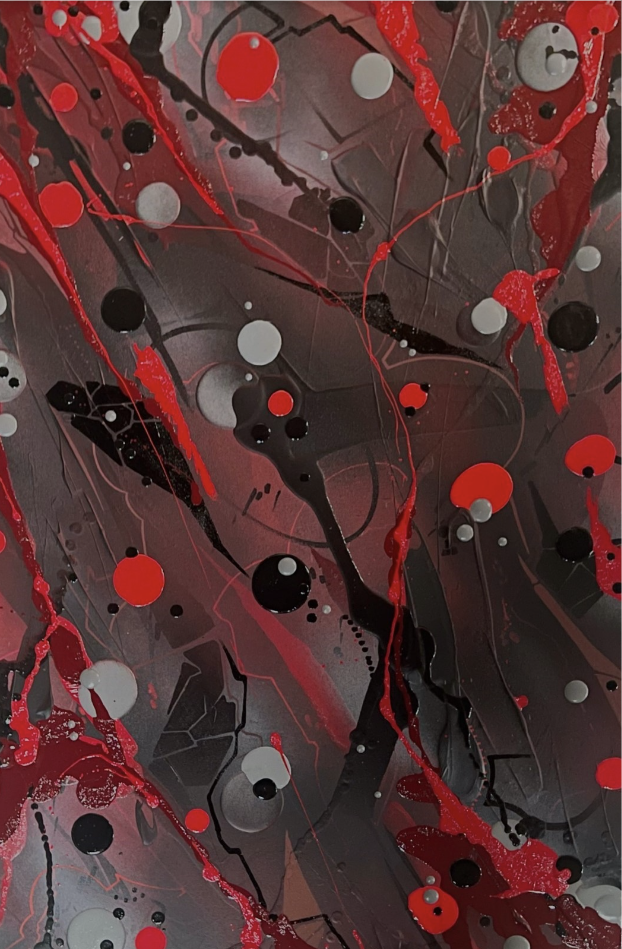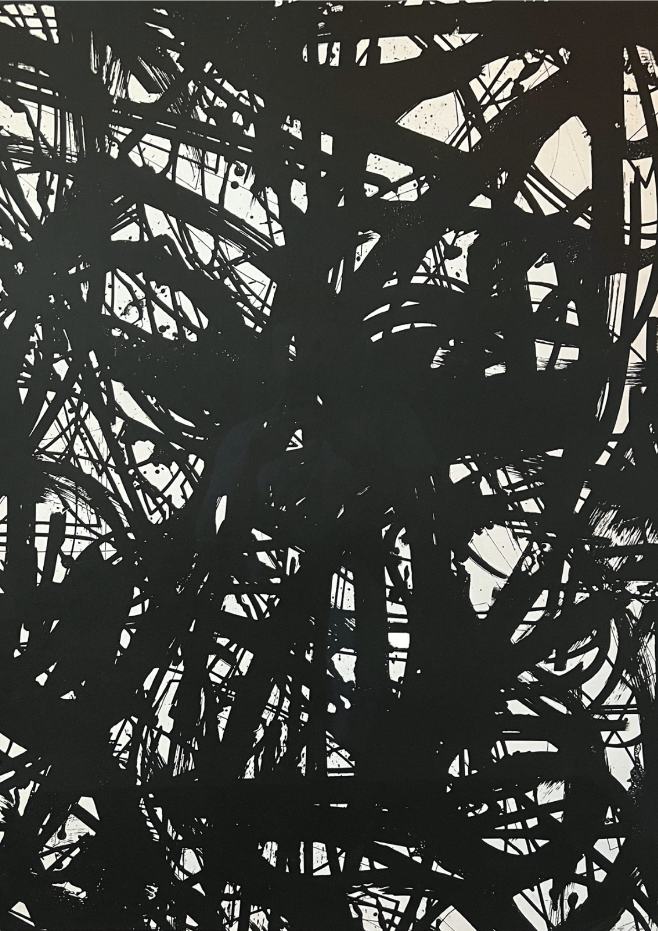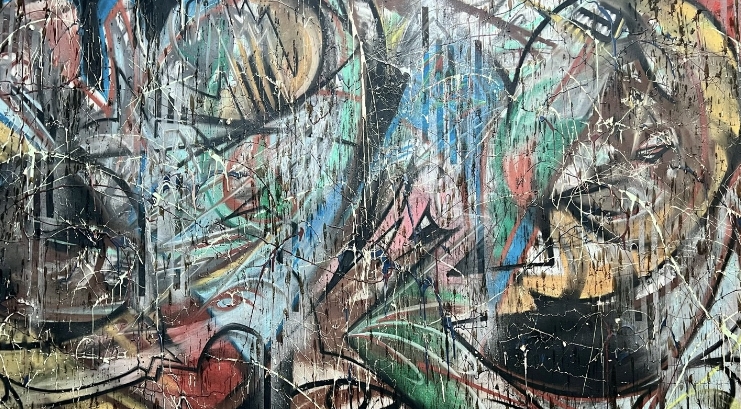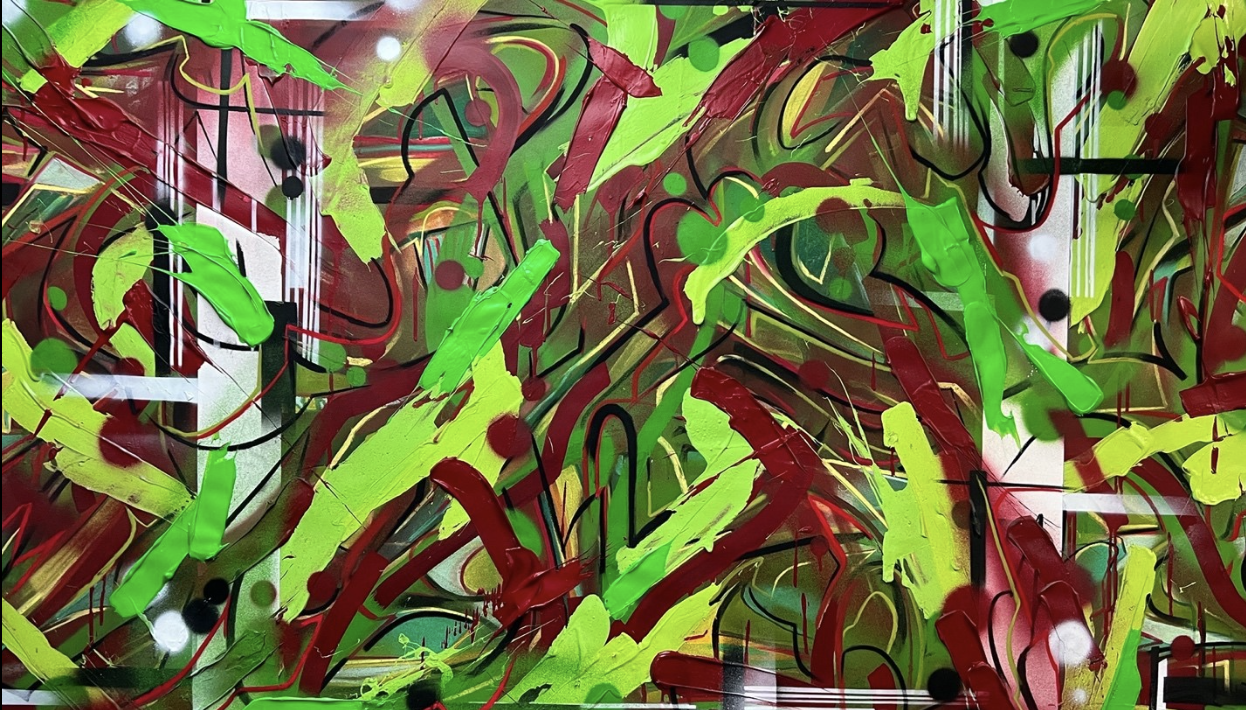This February, artist Kipton Hinsdale shares the story of his dual upbringing in the The Evolution of Mark Making, a solo exhibition presented at Distortion Society (Beacon, NY). In this collection of abstract work, we journey through the defining moments of Hinsdale’s artistic development from the streets of Brooklyn to the thick woods of Chatham, NY. Interweaving the raw energy of graffiti alongside the meditating rhythms of nature, Hinsdale paints in a unique language of courageous strokes and energetic marks. This exhibition serves as a visual timeline, tracing Hinsdale’s evolution as an artist through the environments that shaped him.
Raised amidst the vibrant chaos of Brooklyn and the serene expanses of upstate New York, Hinsdale has always been drawn to the tension between these contrasting worlds. Early in his career, his fascination with building and the physicality of space led him to explore wood and bronze sculpture. However, it was through experimenting with printmaking techniques like lithography and woodcut that his interest in the interplay of line and texture truly took shape. These experiments allowed him to reimagine his sculptural work in two dimensions, blending abstraction with the raw, expressive language of graffiti and laying the foundation for his distinctive artistic language. Much like the allover paintings of the abstract expressionist movement, Hinsdale’s work continuously engages the viewer’s eye with layered compositions where intention and spontaneity intersect.
Pulling from the history of the city walls and the earthy tones of the rural landscape, The Evolution of Mark Making reflects the dynamic interplay between the urban and natural worlds. It investigates the moments where chaos and control intersect, and the journey through emotional release. Working with a wide array of materials, including pastels, spray paint, acrylic, ink, wax, house paint, and charcoal, Hinsdale honors the energy contained in each media. He acts as a conductor, guiding the materials through layered movements of harmony and dissonance. Every mark—whether chaotic or serene, deliberate or spontaneous—finds its place in the intricate tapestry of his work.

Acrylic, paint marker, 1-Shot and spray paint on paper. 36 x 24 inches.
INTERVIEW BETWEEN MICHELLE SILVER (GALLERY DIRECTOR, DISTORTION SOCIETY) AND KIPTON HINSDALE
MS: We’re excited to present The Evolution of Mark Making this February. You’ve said that this exhibition serves as a visual timeline that traces your evolution as an artist through the environments that shaped you: specifically, Brooklyn and Chatham, NY. Can you provide some insight into what it was like growing up in these two disparate environments? Did you favor one place over another at different times in your life?
KH: Chatham has always been a special place for me and my family, a kind of getaway. My uncles, Tom Gilling and Michael Vanhorn, who are also my art mentors, live there. When I was younger, I spent countless weekends in Chatham studying drawing under their guidance.
Brooklyn, on the other hand, has been a constant source of inspiration. My first studio was actually in my parents’ basement, in my father’s workshop. It was a space where I could throw around ink and paint to my heart’s content. Complete freedom to express myself. Living in Brooklyn also meant easy access to the art world – I could hop on a train and be at the museums and galleries in no time. That exposure was invaluable.
I started studying art in Manhattan, at LaGuardia High School, which is where I was introduced to graffiti. It transformed the city for me, turning the streets and subway system into a public and private gallery of sorts. It was this explosion of creativity that was impossible to avoid, even if I’d wanted to.
During my junior year at SUNY Purchase, my dad bought property in Chatham and started building a house there. My family lived on that property for years, maintaining it until we eventually sold it.
Both places are integral to who I am. Each call to me when I’m away for too long, and I couldn’t imagine life without either one. So no, I can’t choose between them, I love them both equally.

Large offset B and W lithography print on paper. 47 x 37 inches.
MS: Can you describe a defining moment in your artistic development?
KH: My off time from work/college was spent going up to Chatham to help my dad with the construction of the house. On the property, deep in the forest and away from the house, there was an old farm shed that I turned into my studio. That completely changed the game for me. Being surrounded by nature had a profound impact on me and I became immersed in it. My sharp, industrial, abstract street style started unconsciously adapting to the fluid and lush natural elements around me. That’s where I feel my style was truly born. It all clicked together in my mind.
MS: As a painter myself, I’ve often thought about what my retrospective would one day look like, and how there would be certain pieces that really stood out to me as the work that pushed me to the next phase. And it got me thinking about how creative evolution is not always linear, but rather it’s oftentimes cyclical. I realize this isn’t a retrospective by any means, but I love that you’re creating new work that deals with these different points in your life, in addition to reworking drawings from years ago and even including a couple of older pieces. Can you talk a little about your thought process in developing the idea for this show?
KH: Since your gallery is in Beacon, so close to both Chatham and Brooklyn, I felt it was the perfect time to share the origins of my style and where it all began. The idea of revisiting those roots felt natural, almost inevitable. At first, I thought, ‘Oh, I need to make all these frames,’ but then it struck me how symbolic that was. I started making my own frames in Chatham with my father. A great bonding experience in which we still do to this day. Each time we frame we learn something new and are able to improve the style and strength of the frame.
As I worked on this show, everything started speaking to me about the beginning. Those formative experiences that shaped my process and vision. It was like the work itself was pulling me back to the core of my practice. This show isn’t just about the pieces, it’s about tracing the creative threads that connect my industrial, street-inspired style to the natural and personal elements that emerged when I built my first studio in the woods. It’s about showing how those worlds collided and how that collision became my artistic voice.

Pastel, wax, house paint, spray paint and charcoal on paper. 33 x 58 inches.
MS: Have there been any big surprises along the way? Any discoveries?
KH: While working in my Brooklyn studio, I was surprised by how vividly the memories of creating in the woods kept surfacing. It wasn’t just nostalgia; it was a reminder of how deeply that environment shaped my process. In Brooklyn, my work tends to reflect the energy of the city, but as I created for this show, I noticed natural, fluid elements sneaking back in, almost as if my time in the woods was guiding me.
I realized that even though I visit upstate often, I miss the act of creating in that environment. There’s a balance between the two spaces, city and nature, that I hadn’t fully appreciated before. It’s made me think differently about how the places I create in, impact the work itself.
MS: What do you hope viewers take away from the exhibition?
KH: I want viewers to find something in each piece that resonates with them personally. I get so excited when they see something I didn’t intend, when they add their own interpretation to the subject matter I’ve provided. It’s like looking at clouds and abstracting them with your mind. How they’re always shifting, and you use your imagination to create objects or places out of them.
The dialogue that comes from describing what I see and hearing what the viewer sees is incredible to me. It creates a shared experience that evolves with each interaction.
____________________________
The Evolution of Mark Making will be on view at the combined contemporary art gallery and tattoo studio Distortion Society, 155 Main Street, Beacon, NY. The gallery is in the front and is free and open to the public. The exhibition will run through April 5, 2025.
www.distortionsociety.com | www.instagram.com/distortion_society
______________________________
Author’s Bio:
Michelle Silver is the Co-Founder and Gallery Director of a combined art gallery and tattoo studio in Beacon, NY called Distortion Society. She is also a freelance branding and web designer and studio artist focusing on oil paintings that blend abstraction, figurative elements, and emotional landscapes.
www.michellesilverart.com | www.instagram.com/michellesilverstudio



2 Comments
Interviewer and invited artist both shared their thoughts in viscerally descriptive manor that made it a joy to read. The photos of Kipton’s art are beautiful. Thank you.
It is wonderful. Hard to pick a personal fave, but the pastel from 2009 reached out and grabbed me!